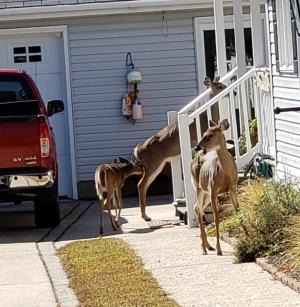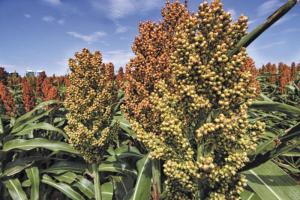Richard and Peggy Martin keep me up to date with Lewes Beach wild animal news as viewed from their Cedar Street home. Richard recently sent me the photograph that appears here along with the following information:
“Mommie DEERest introducing her twins to the Martin Back-Deck Bistro. They dined on four Sedum (Autumn Joy) plants as appetizers, seven Chrysanthemums for the entree, and a variety of Geraniums for dessert. I don't know if they rested on the glider when finished, but it appears that they really enjoyed their visit. As soon as I learn deer speak, I will tell them about all the new vegetation at Showfield just off of Gills Neck Road.”
Between deer, wild turkeys, skunks, foxes, raccoons, coyotes, possums and all the other four-legged, two-legged, two-winged, finned and slithering creatures that inhabit our natural world, we have a lot to be good stewards for.
Sorghum observations
It’s hard to say why there were more fields of sorghum planted on Sussex farms this year, but a number of readers have remarked about the appearance of the crop sprinkled in with the more prevalent corn, wheat and soybeans.
When I saw sorghum butter show up on the menu of Adrift in Whitestone, Virginia, last weekend, it piqued my curiosity.
According to an article on the Food and Wine internet site, “A new generation of Southern chefs has recently reintroduced sorghum to the public.”
In the case of sorghum butter, it was part of a distinctly Southern dish that included buttermilk fried rabbit served on a waffle along with maple syrup. If you wanted to forgo the maple syrup, you could still enjoy sweetness from the sorghum butter.
From the same internet article: “Sorghum syrup is made from the green juice of the sorghum plant, which is extracted from the crushed stalks and then heated to steam off the excess water, leaving the syrup behind.”
Often associated with molasses, sorghum syrup is an old-fashioned sweetener. One characterization said sorghum syrup’s flavor has more depth and shows “rustic nuttiness.”
Although sweet syrup is a valued byproduct of sorghum, this Old World grass resembling corn and dating back to 8,000 B.C. Africa, is cultivated primarily for its grain. The kernels are harvested for animal feed and for the production of ethanol used in 98 percent of the gasoline sold in the U.S.
Grain farmers with marginal, nonirrigated soils like sorghum because it produces a decent crop even in drought conditions. That’s why it is prevalent throughout the South and making incursions into the Mid-Atlantic states including Delaware.
While corn requires at least 21 inches of water for a high-yielding crop, sorghum can get by with eight inches. The price of its seed, about a tenth of that of corn seed, also makes it economically attractive. Kansas tops the list of sorghum growers. That state’s farmers grow nearly 3 million acres each year.
But people are eating more sorghum now than ever before.
Contributing to its rising popularity is sorghum’s gluten-free grain, making its flour attractive to those with celiac disease and other gluten sensitivities. According to the National Sorghum Producers website, sorghum grain and syrup are now used in 350 different consumer food product lines.
Delaware Department of Agriculture Deputy Secretary Ken Bounds said Delaware farmers grow sorghum as a good rotation crop on nonirrigated land. He said most of the Delaware sorghum goes for chicken feed. Some, he said, goes to Pennsylvania for bird seed.
A simple way to sample sorghum syrup is to mix it in with butter and use on pancakes or waffles, or syrup-glaze a tray of root vegetables and roast them. Doing so, you’ll be tapping into part of Sussex County’s Southern side.


























































